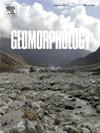黄河中下游现代沉积物矿物学调查及不同粒度组分物源分析
IF 3.1
2区 地球科学
Q2 GEOGRAPHY, PHYSICAL
引用次数: 0
摘要
黄河是世界上悬沙量最大的河流。在历史上,大量的泥沙供给和快速的泥沙积累造成了无数的河道决口和改道等洪水灾害。了解沉积物特征和潜在源区的相对贡献对于识别高浓度水流的形成和实施水沙调节工程具有重要意义。本文结合黄河中下游及其支流、海河流域和淮河流域的52个现代河床沉积物样品的矿物分析(粘土矿物和重矿物),探讨了黄淮海平原沉积物的输运过程。利用频率模型计算黄河下游各潜在源区对不同粒度泥沙的相对贡献。研究结果表明,粘土级沉积物主要来自渭河盆地和黄土高原南部,而粗粒沉积物(>;30 μm)主要由金山峡(干流)及其西部支流供给。本研究强调了黄河下游不同粒度泥沙来源的非均质性。这将为进一步研究高浓度流的形成机制提供新的思路。研究结果为黄河中游水土保持和水沙调控策略的制定提供了理论依据;为今后玉溪峡连通性研究以及黄河转淮相关的沉积地貌研究提供了基础物源分析资料。本文章由计算机程序翻译,如有差异,请以英文原文为准。
Mineralogical investigation of modern sediments and source analysis of different grain-size fractions in the middle and lower Yellow River
The Yellow River has the highest suspended sediment load among the Earth's big rivers. High sediment supply and rapid sediment accumulation caused numerous flood disasters such as channel breaches and diversions through history. Understanding sediment characteristics and relative contributions from potential source areas is important for recognizing the formation of hyperconcentrated flows and implementing water and sediment regulation projects. We here combine mineral analyses (clay minerals and heavy minerals) of 52 samples of modern riverbed sediments from the middle and lower reaches of the Yellow River and its tributaries, the Haihe River Basin, and the Huaihe River Basin to explore sediment-transport processes in the Huang-Huai-Hai Plain. Frequency models are used to calculate the relative contributions of each potential source area to the sediments of different grain-size in the lower Yellow River. Our results show that clay-sized sediments originate mainly from the Weihe Basin and the southern Loess Plateau, whereas coarser sediments (> 30 μm) are primarily supplied by the Jinshaan Gorge (the mainstream) and its western tributaries. This study underscores the heterogeneity of sediment sources of sediments with different grain-size in the lower Yellow River. It will shed new light on further research on the mechanisms of the formation of hyperconcentrated flows. Our findings contribute to the formulation of strategies for water and soil conservation and water-sediment regulation in the middle Yellow River; and they provide fundamental provenance analysis data for future studies of the connectivity of the Yuxi Gorge, and sedimentary and geomorphological research related to the diversion of the Yellow River to the Huaihe River Basin.
求助全文
通过发布文献求助,成功后即可免费获取论文全文。
去求助
来源期刊

Geomorphology
地学-地球科学综合
CiteScore
8.00
自引率
10.30%
发文量
309
审稿时长
3.4 months
期刊介绍:
Our journal''s scope includes geomorphic themes of: tectonics and regional structure; glacial processes and landforms; fluvial sequences, Quaternary environmental change and dating; fluvial processes and landforms; mass movement, slopes and periglacial processes; hillslopes and soil erosion; weathering, karst and soils; aeolian processes and landforms, coastal dunes and arid environments; coastal and marine processes, estuaries and lakes; modelling, theoretical and quantitative geomorphology; DEM, GIS and remote sensing methods and applications; hazards, applied and planetary geomorphology; and volcanics.
 求助内容:
求助内容: 应助结果提醒方式:
应助结果提醒方式:


